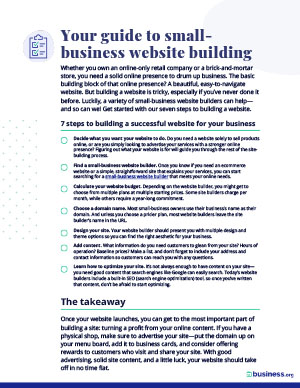We are committed to sharing unbiased reviews. Some of the links on our site are from our partners who compensate us. Read our editorial guidelines and advertising disclosure.
Cheap Domain Name Registration for Small Business
Data as of 10/20/22. Offers and availability may vary by location and are subject to change.
Owning your own business can be expensive (we know, preaching to the choir here). With that in mind, we at Business.org look for ways to help business owners save money wherever they can—which is why we’ve compiled a list of the most affordable places you can register a domain for your small-business website.
We’ve even broken down their affordability by category so you can choose the domain registrar that makes the most sense with your particular budget and needs.
Let’s get our thrift on!
Cheapest domain registration sites
- : Most affordable overall domain registrar
- : Cheapest gTLD domains
- : Cheapest domain/hosting bundle
- : Cheapest first-year registration
- : Cheapest .com renewal and transfer
- : Best for old-school TLDs
- : Best for bulk domain registration
- : Best if you need to choose a URL
- : Best for protecting your site

Business.org’s top domain name registrars
Data as of 10/20/22. Offers and availability may vary by location and are subject to change.
Google Domains: Most affordable overall domain registrar
Data as of 10/20/22. Offers and availability may vary by location and are subject to change.
Look, Google Domains doesn’t have the lowest prices on anything. What does it have, you ask? Just domains—which might be a great way to keep your costs down. While other domain registration sites constantly try to upsell you on everything from hosting to email accounts to security, Google Domains sells you just a domain. So if you want a straightforward registrar that won’t tempt you to overspend, try Google Domains.
And best of all: Google Domain's prices don't generally increase after the first year. So while it might not seem the cheapest option at first, that's only because other registrars offer a low price for the first year but increase it thereafter. Not so much with Google Domains, though.
Namecheap: Cheapest gTLD domains
Want to give your business’s web address a little flair and make it stand out from the crowd? When you’re choosing a domain name, forget .com and go with .pizza or .diamonds or one of the many other gTLDs (generic top-level domains) that have been released in the past few years—and get that gTLD from Namecheap, who offers the best prices on gTLDs from .app to .zone.
Namecheap domain pricing
Data as of 10/20/22. Offers and availability may vary by location and are subject to change.
While other registrars also have low first-year registration prices for gTLDs, Namecheap easily has the best renewal prices (though, full disclosure, those renewal prices are still much higher than the initial domain registration cost). As an added bonus, Namecheap has the least-aggressive upselling we’ve seen, so you won’t get roped into spending more than you wanted to. If a gTLD sounds right for your business, go with Namecheap.
By signing up I agree to the Terms of Use and Privacy Policy.
DreamHost: Cheapest domain/hosting bundle
Several of the domain registration sites on this list offer web hosting in addition to domains—many even offer a free domain when you get hosting services—but DreamHost offers the best deal with its dirt-cheap domain hosting/registration bundle. (DreamHost happens to be our pick for inexpensive VPS hosting.) DreamHost’s three-year shared web hosting starts at the same price point as a bean burrito, and its shared hosting plans include a free domain.
DreamHost hosting pricing
Data as of 10/20/22. Offers and availability may vary by location and are subject to change.
Now there are some conditions: this only applies to businesses willing to sign up for a one-year hosting account, and that free domain registration is just for one year (after which you’ll have to pony up for the renewal cost). Also, the ultra-low hosting costs may go up a little to very-low hosting costs at the end of your plan. But for bundling hosting and a domain name, DreamHost is tough to beat.
DreamHost domain pricing
Data as of 10/20/22. Offers and availability may vary by location and are subject to change.
GoDaddy: Cheapest first-year registration
Sometimes you need what’s cheapest now, even if it’s not the best overall and could cost you later (we call it the “college student eating Top Ramen” principle). And if that’s the boat you’re in—you just need the cheapest domain you can get today—then GoDaddy is your best bet. It offers cut-rate domain registration prices that you can’t beat anywhere else.
GoDaddy domain pricing
*two-year purchase required
Data as of 10/20/22. Offers and availability may vary by location and are subject to change.
Sure, its prices go up a lot when you renew your domain, but you can always jump ship and transfer your domain somewhere else. Just watch out for GoDaddy’s aggressive upselling; if you’re not careful, you’ll end up with a pocketful of extras—and out the cash you’d hoped to save.
Special GoDaddy offer
Business.org readers get a special discount from GoDaddy—get a free domain with $1/month hosting!
Dynadot: Cheapest .com renewal and transfer
But maybe you’re more of a long-term thinker (how admirable!). In that case, Dynadot might be more your speed. While its first-year pricing isn’t the lowest we’ve seen (though it is still competitive), Dynadot has the best renewal pricing for .com domains. So if you want to have an affordable domain for year two, three, and so on, think Dynadot.
Dynadot domain pricing
Data as of 10/20/22. Offers and availability may vary by location and are subject to change.
Plus, Dynadot offers excellent domain transfer pricing. In almost all cases, its transfer costs are the same as its renewal costs. If you bought a domain elsewhere but want to escape hefty renewal fees, you can transfer that domain to Dynadot for a good deal. So whether you’re renewing or transferring your web domain, Dynadot’s good for the long haul.
Honorable mentions
HostGator: Best for traditional TLDs
HostGator stands out in the domain registration world for offering only 15 TLDs (top-level domains)—mostly traditional extensions, like .com, .biz, .net, etc. That means HostGator could save you money on your domain name search, given that .coms and .nets tend to be far cheaper than newfangled extensions like .diamonds and .pizza. So if you want to keep things simple—and affordable—HostGator will steer you in the right direction.
Name.com: Best for bulk domain registration
You can often get a discount on domains when you purchase them in bulk—and that’s something Name.com happens to be very good at. Name.com lets you sift through domains by category (the social category, for example, includes gTLDs like .club and .buzz) or by selecting the domain suffixes you want. If you plan to get multiple domains for your business site(s), then Name.com’s bulk buying might save you a lot of dough.
Hover: Best for helping you choose
Hover has great tools to help you choose a domain name. That can help if your URL of choice has already been taken (ugh), but it can also help you find a cheaper alternative if you find out that your desired domain name costs big bucks. If you type in a domain you want (probably your business name), Hover will suggest both wording variations (like adding a “the”) and suffix variations—and you just might find one that saves you money.
Domain.com: Best for protecting your site
Domain.com offers some great security features for your site, including upgraded SSL certificates, site backups, security scans, and domain privacy. While those will cost you a little extra, they could easily end up saving you money in the long run. Like they say, an ounce of site protection is worth a pound of hiring someone to fix your website after it gets hacked or accidentally broken. Let Domain.com save you money with extra security.
The takeaway
Building a business website—whether you’re building a blog, an online store, or just a simple online presence for your brick-and-mortar store—shouldn’t cost you an arm and a leg. With our list of the cheapest domain registrars, you can snag a great deal on the URL of your dreams without skimping on quality.
So go ahead: get the perfect domain for your business website, whether it’s a .com or .pizza—with everything from .academy to .zip, you’ve got plenty of options.
Once you’re done registering a domain, check out our rankings of the best web hosts and our favorite website builders.
Related reading
FAQs about domain registration
What else can a domain registrar do for me?
Most domain registration sites can do a whole lot more than just register a domain or two. Registrars often offer web hosting (including shared, VPS, and dedicated hosting), custom email accounts, SSL certificates for your site—basically anything you need to create a business website.
In fact, many domain registration sites are web hosting services first, domain registrars second. Go figure.
What’s the difference between TLDs like .com, .me, and .pizza?
Well, they’re all valid domain extensions. But before you leave behind .coms forever, there are a couple things to consider.
Like professionalism. We’ve said it before and we’ll say it again: you probably wouldn’t trust this ranking as much if it were housed at Business.pizza instead of Business.org. So think about whether or not a non-standard extension would work for your business. It’s one thing to be Dominos.pizza, but another thing entirely to be MortsMortuary.pizza.
Then there’s price. In theory, gTLDs like .pizza were created to give people more domain options. The catch? They cost a lot more than the supposedly scarce .com domains tend to. That’s not always the case—a highly desirable domain, like google.com, would probably cost more than a variation like google.pizza. But generally, gTLDs cost more than their traditional counterparts—hence our pricing charts including costs for both.
Finally, there’s search engine optimization. If you want your website to be findable via Google and Bing, you might want to stick with a .com website. At least for now, search engines tend to favor .coms and other traditional TLDs over new gTLDs.
But as long as you understand those considerations, there’s no reason you shouldn’t choose a funky TLD for your business. Have fun with it.
Does my domain registrar have to be my web host too?
Nope. You can buy a domain from any registration site you want and then make your website with a different host or website builder. So go ahead, register with 1&1 IONOS and then create a WordPress website, or buy your domain from Namecheap and build with Wix. Follow your heart.
Now, you will need to update your DNS (domain name server) to make sure your domain is properly linked to where your website is actually hosted. It’s an easy process that mostly involves a little copying and pasting, but the steps vary from registrar to registrar. But whatever registrar you choose should have a how-to guide (for example, how to connect a 1&1 IONOS domain with a WordPress site).
If you get stuck, just ask customer service.
Methodology
To find the best domain registration options, we considered pricing plans, customer support, and how it worked to transfer a domain. We also looked at how many domains were offered and whether these sites were flexible with discounts.
Disclaimer
At Business.org, our research is meant to offer general product and service recommendations. We don't guarantee that our suggestions will work best for each individual or business, so consider your unique needs when choosing products and services.











